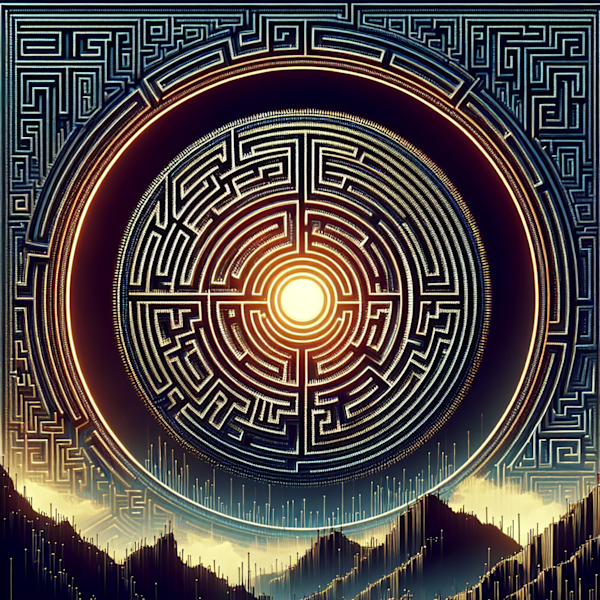Pan's Labyrinth (2006)

Pan’s Labyrinth is a Spanish-Mexican dark fantasy film directed by Guillermo del Toro. Released in 2006, the film received critical acclaim for its unique storytelling, stunning visuals, and intricate themes. In this blog post, we will explore the various aspects of Pan’s Labyrinth and delve into why it has become a cult classic over the years.
The Plot and Setting
Set in the aftermath of the Spanish Civil War, Pan’s Labyrinth follows the story of a young girl named Ofelia who discovers a mysterious labyrinth near her new home. As she navigates through the labyrinth, Ofelia encounters a faun named Pan who believes her to be the reincarnation of the princess of the underworld. Pan gives Ofelia three tasks to complete in order to prove her identity and claim her rightful place as princess.
Meanwhile, Ofelia’s brutal stepfather, Captain Vidal, hunts down rebels in the forest, creating a stark contrast between the fantastical world of the labyrinth and the harsh reality of war-torn Spain. As the two storylines intertwine, Ofelia must make difficult choices that will ultimately determine her fate.
Themes and Symbolism
Pan’s Labyrinth is rich in symbolism and explores themes such as innocence, sacrifice, and the power of imagination. The film blurs the lines between reality and fantasy, leaving viewers questioning the true nature of the events unfolding on screen. Del Toro masterfully weaves together elements of fairy tales and historical drama to create a complex narrative that resonates on multiple levels.
One of the central themes of the film is the loss of innocence in the face of violence and oppression. Ofelia’s journey through the labyrinth serves as an allegory for her inner struggle to hold onto her childhood innocence in a world filled with darkness and despair. The character of Pan represents the last remnants of magic and wonder in a world plagued by cruelty, offering Ofelia a glimpse of hope amidst the chaos.
Visuals and Design
One of the most striking aspects of Pan’s Labyrinth is its visual aesthetic. Del Toro’s masterful use of practical effects and intricate set design creates a hauntingly beautiful world that feels both fantastical and grounded in reality. From the eerie creatures that populate the labyrinth to the lush forests that conceal dark secrets, every frame of the film is a work of art in its own right.
The design of the Faun and the Pale Man, two key creatures in the film, is particularly noteworthy. The Faun’s intricate costume and prosthetics bring the character to life in a way that CGI could never replicate, while the Pale Man’s grotesque appearance sends shivers down the spine of viewers. Del Toro’s attention to detail in every aspect of the film’s production elevates Pan’s Labyrinth from a simple fantasy film to a visual masterpiece.
Impact and Legacy
Since its release, Pan’s Labyrinth has garnered a cult following and has been hailed as one of the greatest fantasy films of all time. Its thought-provoking themes, stunning visuals, and compelling storytelling have cemented its place in cinematic history. The film has won numerous awards, including three Academy Awards for Best Cinematography, Art Direction, and Makeup.
Pan’s Labyrinth has also inspired a new wave of dark fantasy films that push the boundaries of traditional storytelling. Its influence can be seen in works such as The Shape of Water, another del Toro film that explores similar themes of fantasy and reality blending together. As audiences continue to revisit and analyze Pan’s Labyrinth, its impact on the world of cinema only continues to grow.
Conclusion
In conclusion, Pan’s Labyrinth is a timeless masterpiece that transcends the bounds of genre and language. Its blend of fantasy and reality, coupled with its poignant themes and stunning visuals, make it a film that resonates with viewers long after the credits roll. Guillermo del Toro’s unique vision and attention to detail have created a work of art that stands the test of time. Whether you’re a fan of fantasy films or simply appreciate captivating storytelling, Pan’s Labyrinth is a must-see for any cinephile.

Olivia Bell
Film Critic
More From Classics Authority Movies

Movie
Army of Shadows (1969)

Movie
Rebel Without a Cause (1955)

Movie
Memento (2000)

Movie
Oldboy (2003)

Movie
Indelible Child Stars: Classic Movies that Introduced Young Talent

Movie
Who's Afraid of Virginia Woolf? (1966)





